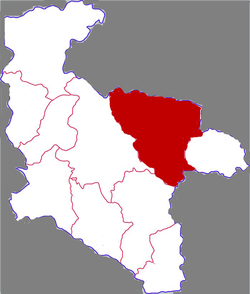Xunyang, Shaanxi
Xunyang
旬阳市 Sunyang; Sünyang | |
|---|---|
 Xunyang in Ankang | |
 Ankang in Shaanxi | |
| Coordinates: 32°50′03″N 109°21′55″E / 32.8341°N 109.3653°ECoordinates: 32°50′03″N 109°21′55″E / 32.8341°N 109.3653°E | |
| Country | People's Republic of China |
| Province | Shaanxi |
| Prefecture-level city | Ankang |
| Area | |
| • Total | 3,540.8 km2 (1,367.1 sq mi) |
| Population (2019) | |
| • Total | 450,122 |
| • Density | 130/km2 (330/sq mi) |
| Time zone | UTC+8 (China standard time) |
| Postal code | 725700 |
| Licence plates | 陕G |
| Website | www |
Xunyang (simplified Chinese: 旬阳市; traditional Chinese: 旬陽市; pinyin: X��nyáng Shì; formerly written as (Chinese: 洵陽) until 1964)[1] is a county-level city in the south of Shaanxi province, China, bordering Hubei province to the northeast and southeast. It is under the administration of the prefecture-level city of Ankang. Its administrative seat is in the town of .[2] The county covers an area of 3,540.8 square kilometres (1,367.1 sq mi),[2] and has a population of 450,122 as of 2019.[3]
History[]
During the Spring and Autumn period, the area of present-day Xunyang County belonged to the State of Chu.[4]
In the Warring States period, the area was incorporated as .[4]
In 312 BCE, Xunyang County was taken by the State of Qin following the .[4]
Later, the area became part of the Han Dynasty, where is was placed under the .[4]
During the Qing Dynasty, the area belonged to the .[4]
From 1914 to 1928, the area belonged to .[4] From 1928 to 1949, the area was directly administered by Shaanxi Province.[4]
Since the establishment of the People's Republic of China in 1949, the county has belonged to Ankang.[4] In 1964, its name was changed from Xunyang County (Chinese: 洵阳县; pinyin: Xúnyáng Xiàn) to Xunyang County (Chinese: 旬阳县; pinyin: Xúnyáng Xiàn), due to the uncommon nature of the previous first character.[4]
Geography[]
Xunyang is located in the Shaanan region, approximately 220 kilometres (140 mi) from Xi'an.[2] To the county's north lies the Qinling Mountains.[2] The Han River flows through the county, as well as a number of its tributaries, such as the , the , the , the , the , the , and the .[2]
Climate[]
Xunyang County has an average annual precipitation of 777 millimetres (30.6 in).[2]
Government[]
In 2019, the county government earned ¥1.877 billion in fiscal revenue, and spent ¥3.994 billion in fiscal expenditures.[5]
Administrative divisions[]
As of 2020, Xunyang County is divided into 21 towns.[6]
|
|
|
|
Demographics[]
As of 2019, Xunyang County has a population of 450,122 people, who reside in 149,961 households.[3] The county's dominant ethnicity is Han, but populations of Hui, Manchu, Korean, Tujia, Nakhi, Mongol, Miao, Kam, and Yi people reside within the county.[3]
Economy[]
In 2019, Xunyang County reported a gross domestic product (GDP) of ¥18.705 billion, an 8.4% annual increase.[5] The county's per capita GDP rose 8.0% to ¥42,982.[5] 10.6% of the county's GDP came from its primary sector, 52.5% came from its secondary sector, and 36.9% came from its tertiary sector.[5] The county's public sector accounted for 41.9% of its GDP.[5]
Agriculture[]
The county's main agricultural products include various grains, oils, tobacco, and vegetables.[5] In 2019, the county had about 1 million heads of poultry, 205 thousand heads of swine, 134 thousand heads of goats, and 67 thousand heads of cattle.[5] The county also has sizable aquaculture and forestry industries.[5]
Industry[]
Major industries in Xinyang County include the production of medicine, cement and building materials, hydropower, equipment manufacturing, tobacco, food products, and mining.[5] Xunyang County is home to deposits of mercury, antimony, aluminum, zinc, gold, barite, and slate.[2]
Retail[]
In 2019, the county experienced a total of ¥5.757 billion in consumer retail sales.[5]
Transport[]
Road[]
National Highway 316 passes through the county.[2] The , part of the G65 Baotou–Maoming Expressway, passes through the county.[citation needed] also passes through Xunyang County.[citation needed]
Rail[]
14 train stations serve the county, which is home to 128 kilometers of railroad.[citation needed] The Xiangyang–Chongqing railway passes through Xunyang County,[2] as does the Xi'an–Ankang railway.[citation needed]
Notes[]
- ^ "1956年以来更改生僻县名用字研究 - 百度文库". wenku.baidu.com. Archived from the original on 2021-08-24. Retrieved 2021-08-24.
- ^ Jump up to: a b c d e f g h i 旬阳县概况地图. xzqh.org (in Chinese). 2015-07-01. Archived from the original on 2021-01-02. Retrieved 2021-01-02.
- ^ Jump up to: a b c 人口民族. xyx.gov.cn (in Chinese). Xunyang County People's Government. 2020-07-23. Archived from the original on 2021-01-02. Retrieved 2021-01-02.
- ^ Jump up to: a b c d e f g h i 旬阳县历史沿革. xzqh.org (in Chinese). 2015-07-01. Archived from the original on 2021-01-02. Retrieved 2021-01-02.
- ^ Jump up to: a b c d e f g h i j 经济发展. xyx.gov.cn (in Chinese). Xunyang County People's Government. 2020-07-23. Archived from the original on 2021-01-02. Retrieved 2021-01-02.
- ^ 2020年统计用区划代码(旬阳县) (in Chinese). National Bureau of Statistics of China. 2020. Archived from the original on 2021-01-02. Retrieved 2021-01-02.
External links[]
- "旬阳县概况地图沿革 (Overview, History and Map of Xunyang)" (in Chinese). Archived from the original on 13 November 2012.
- "走进旬阳 (About Xunyang)" (in Chinese). Archived from the original on 6 December 2011.
- Xunyang County Government Website (2020)
- County-level divisions of Shaanxi
- Ankang

